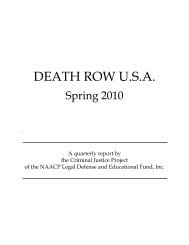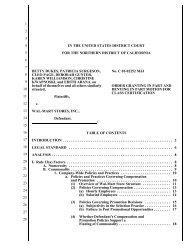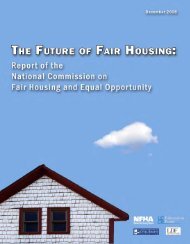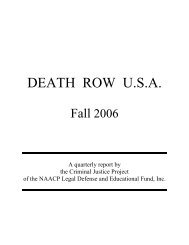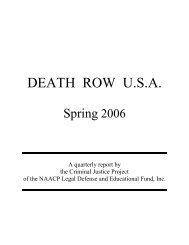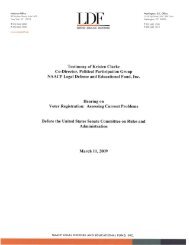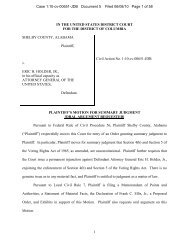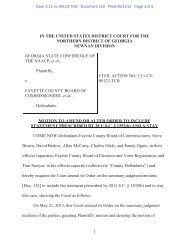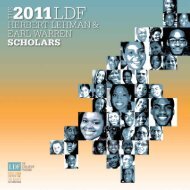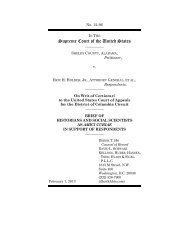Appendices.pdf - NAACP Legal Defense and Educational Fund, Inc.
Appendices.pdf - NAACP Legal Defense and Educational Fund, Inc.
Appendices.pdf - NAACP Legal Defense and Educational Fund, Inc.
Create successful ePaper yourself
Turn your PDF publications into a flip-book with our unique Google optimized e-Paper software.
Specific Strategies u u u <br />
Verbal<br />
his symptoms. The chimp’s illness is not introduced until<br />
the following sentence (U). The resulting paragraph is poorly<br />
organized.<br />
1st<br />
2nd<br />
Clevel<strong>and</strong><br />
Denver<br />
QUSTR is also incorrect. When R, which describes Kalunde’s<br />
flu symptoms, is placed last, the paragraph becomes disjointed.<br />
The previous sentence (T) has said that Kalunde<br />
accomplished his goal of clearing his nasal passages after<br />
using a tool. R describes Kalunde’s condition before he used<br />
his tool, so it should appear earlier in the paragraph, as it does<br />
in the correct order (QURST).<br />
u u u logical reasoning<br />
This section consists of 10 questions that assess your<br />
ability to reason logically, using the facts, concepts, <strong>and</strong><br />
information presented. You must guard against<br />
jumping to conclusions that are not warranted from the<br />
information given. There are different types of questions:<br />
figuring out codes, determining the relative positions of things<br />
or people, identifying correct assumptions, <strong>and</strong> drawing valid<br />
conclusions.<br />
The most important strategy is to read the information carefully<br />
<strong>and</strong> make no assumptions that are not sup ported by the given<br />
information. Certain words must be read carefully. For example,<br />
between cannot be assumed to mean between <strong>and</strong><br />
right next to; other things may be between these two objects<br />
as well. The same may be true of words such as above,<br />
below, before, <strong>and</strong> after.<br />
Another good strategy is to look for information that is definitely<br />
stated, such as, “The red box is the largest,” or “Jane is not<br />
st<strong>and</strong>ing next to Erik.” This information makes it easier to<br />
determine the relative relationships.<br />
For Example 2, draw a diagram to help you determine the<br />
order in which the planes departed. Statement 2 contains definite<br />
information about the Washington plane, so add that to the<br />
diagram:<br />
1st<br />
2nd<br />
3rd<br />
4th<br />
5th<br />
Washington<br />
The remaining planes fly to Boston, Philadelphia, Clevel<strong>and</strong>,<br />
<strong>and</strong> Denver. Statement 3 says that the Denver plane left immediately<br />
after the Clevel<strong>and</strong> plane. (That means no planes<br />
departed between the Clevel<strong>and</strong> <strong>and</strong> Denver planes.) There<br />
are two possible orders, shown below:<br />
3rd Washington OR Washington<br />
4th<br />
5th<br />
Clevel<strong>and</strong><br />
Denver<br />
The information in Statement 1 helps you determine which possible<br />
order is correct. It says that the Boston plane departed<br />
earlier than the Clevel<strong>and</strong> plane. That could not happen in the<br />
first possible order, so the second possible order must be correct.<br />
Because statement 1 also says that the Boston plane<br />
departed later than the Philadelphia plane, the complete order<br />
of departure must be:<br />
1st<br />
2nd<br />
3rd<br />
4th<br />
5th<br />
Philadelphia<br />
Boston<br />
Washington<br />
Clevel<strong>and</strong><br />
Denver<br />
The question asks how many planes left between the departures<br />
of the Boston <strong>and</strong> Denver planes. The answer is two<br />
(the planes departing for Washington <strong>and</strong> Clevel<strong>and</strong>).<br />
Example 2<br />
Exactly five planes departed from an airport, one<br />
at a time.<br />
1) The Boston plane departed later than the<br />
Philadelphia plane, but earlier than the<br />
Clevel<strong>and</strong> plane.<br />
2) The Washington plane departed third.<br />
3) The Denver plane left immediately after the<br />
Clevel<strong>and</strong> plane.<br />
How many planes left between the departures of<br />
the Boston plane <strong>and</strong> the Denver plane?<br />
A. 0<br />
B. 1<br />
C. 2<br />
D. 3<br />
E. Cannot be determined from the<br />
information given.<br />
21



